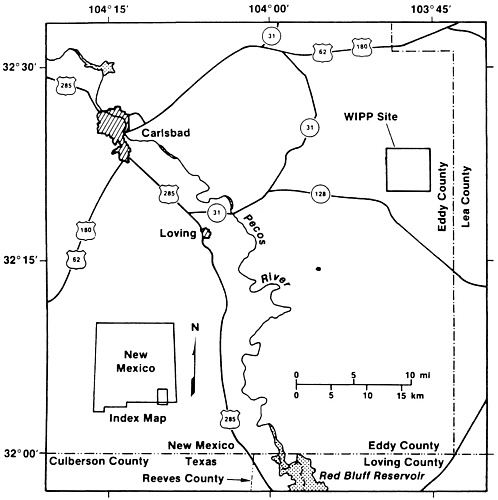Introduction
The Waste Isolation Pilot Plant (WIPP)1 is a series of excavations in a Permian-age bedded salt formation approximately 660 m below the surface near Carlsbad, New Mexico (see Figure 1). Since the mid-1970s, this site has been studied for use as a geologic repository for the disposal of transuranic2 (TRU) waste resulting from the nation's defense program. This waste contains transuranic isotopes, predominantly plutonium isotopes, which are characteristically long-lived radionuclides and therefore a long-term safety hazard. Removing these wastes from the biosphere, for example, through isolation in geologic repositories, is an appropriate strategy for protection of human health and the environment.
At WIPP, packaged waste is disposed by emplacing it in rooms excavated in the salt. Because salt under pressure flows (or “creeps”) and because of the underground pressure exerted on the room ceiling, floor, and walls, over time the salt rock at these surfaces will consolidate around the waste. In time, the salt heals so as to be essentially impermeable, isolating the waste-filled rooms from the rest of the environment.
WIPP is the first deep geological repository that has been designed and engineered for radioactive waste disposal and approved by an external regulatory authority. Operations at WIPP to receive TRU waste and emplace it underground began in 1999, when TRU waste shipments were received from three U.S. Department of Energy (DOE) sites. Drums of TRU waste from the Los Alamos National Laboratory, the Idaho National Engineering and Environmental Laboratory, and the Rocky Flats Environmental Technology Site were first sent to WIPP in March, April, and June 1999, respectively.
The committee has prepared this report to provide findings and recommendations that it considers important for the safe and cost-effective operation of WIPP. The perspective of the committee has been the establishment of “reasonableness” with respect to risks, costs, and the ALARA (as low as reasonably achievable) principle (see footnote 8). The committee believes that the implementation of these recommendations will contribute to the continued safe operation of WIPP.
|
1 |
A complete list of acronyms used in this report appears in Appendix D. |
|
2 |
Transuranic waste contains radionuclides with atomic numbers greater than 92 and half-lives greater than 20 years in concentrations exceeding 100 nanocuries per gram. |
As noted in the preface to this report, the first component of the statement of task is “to identify research activities that would enhance the assessment of long-term repository performance” (see Appendix A). The committee considers that data from radiological site characterization measurements would provide a necessary baseline to compare against future measurements, should the integrity of WIPP ever be challenged. This issue is explored in the next section.
The second component of the statement of task pertains to improvements of the DOE TRU waste management system. To address this issue, the committee sought to identify the technical, regulatory, legal, and/or safety bases of waste management activities that significantly impacted the overall system throughput, efficiency, cost, and safety. These issues are addressed in the last section of this report.

FIGURE 1 Location of the Waste Isolation Pilot Plant. Inset shows the approximate location of the map area in New Mexico. SOURCE: NRC (1996, Figure 1.1.).


